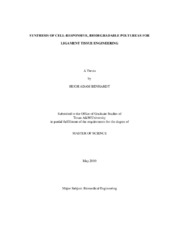| dc.description.abstract | An estimated 200,000 injuries to the anterior cruciate ligament (ACL) occur
annually in the United States, with approximately 100,000 total ACL reconstructions
performed each year. Due to inherent limitations with existing ACL reconstruction
strategies, the development of tissue engineered ligaments is a key area of
musculoskeletal research. Although great strides have been made in the scaffold design,
current strategies are limited by the inability to replicate the mechanical behavior of
native ligament tissue with synthetic polyesters or natural polymers. Poly(ester
urethane)s have recently been investigated as possible scaffold materials because of their
established biocompatibility, excellent mechanical properties, and exceptionally tunable
structure. However, non-specific degradation makes it difficult to tailor polyurethane
structure to complement ligament regeneration. In contrast, a biomaterial that features
system-responsive degradation would integrate with native ligament remodeling and
thus provide effective load transfer to newly formed tissue that is necessary to restore
mechanical integrity.
In this study, enzyme-labile peptide sequences were conjugated to ether-based
polyols to form collagen-mimetic soft segments that feature cell-responsive degradation.
Synthetic routes were first developed to functionalize these polyols with favorable end
groups for peptide coupling. Upon successful conjugation, biodegradable soft segments
were then incorporated into the structure of linear polyurea elastomers. By varying soft
segment chemistry, soft segment molecular weight, and the hard to soft segment ratio, a
library of cell-responsive, biodegradable polyureas was developed. This library can then
be used to elucidate key structure-property relationships necessary to complement
neotissue formation. Overall, synthesis of a novel biomaterial that combines the strength
and tunability of synthetic elastomers with cell-responsive degradation will assist in the
development of an improved tissue engineered graft for ACL reconstruction. | en |


